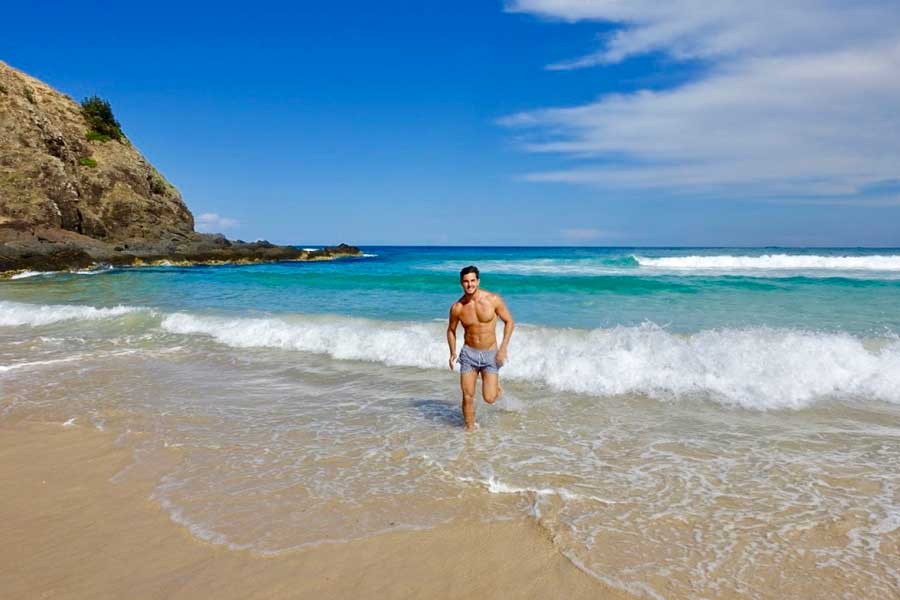6 Simple Steps To Spring Clean Your Health
Spring has sprung! Let’s face it, winter can cause some unwanted changes to your body.

Drew Harrisberg
2017-09-13


Spring has sprung! Let’s face it, winter can cause some unwanted changes to your body.
Maybe you gained some stubborn body fat, lost precious muscle mass, or witnessed your golden tan fade away, but the truth is, not all changes can be seen externally. In fact, the most detrimental changes that happen to your body are internal. In this article, I’m going to share six science-based quick and easy tips to turn your health around in time for summer.
1. Get Some Sun
If you’re somebody who spends the winter months hibernating indoors and/or hiding behind layers of clothing, don’t be surprised when I tell you that your body is experiencing some significant physiological changes that affect your overall health and well-being. As a result of the chronic sun deprivation, a couple of consequences occur: your Vitamin-D levels and UV tolerance plummet!
Even if you are getting some sunlight during the winter, you may not actually be producing much Vitamin-D after all. One study showed that the influence of season and latitude actually prevents the synthesis of Vitamin-D due to a reduction in both quality and quantity of UVB radiation reaching the earth’s surface during the winter months.
Spring is a perfect time to reverse these winter changes because the sun is far less intense than it is during summer, so you can afford to spend more time soaking it up without worrying about getting burnt. Use the spring months to slowly increase your UV tolerance. That way, you’ll be able to enjoy your first beach day of the summer without getting so sunburnt that you end up looking like a lobster.
Vitamin-D deficiency has been shown to increase the risk of developing a multitude of diseases such as cardiovascular disease, common cancers, autoimmune diseases, hypertension, and infectious diseases.
In an article published in the American Journal of Clinical Nutrition, the authors concluded:
'The recommendation for the avoidance of all sun exposure has put the world’s population at risk of vitamin D deficiency. This has become apparent in Australia, where a dramatic increase in skin cancer rates resulted in the promotion of never exposing the skin to direct sunlight without sun protection (i.e clothing or sunscreen). The so-called ‘sun-safe’ message has resulted in a marked increase in the risk of vitamin deficiency in Australia.'
All you need is 5-30 minutes of direct sunlight per day (depending on your skin pigmentation, time of day, and age) to stimulate adequate Vitamin-D production. Direct means no clothing and no sunscreen! Sunscreen blocks the beneficial UV rays that are responsible for stimulating Vitamin-D production.
Research suggests that you should aim to get your daily dose of sunlight between 10 a.m. and 3 p.m. when the sun is powerful enough to get the job done. If you are somebody who burns easily, see how much direct sun exposure you can get away with before getting burnt. The key is not to burn. You may need to apply safe sunscreen after a period of time. That’s right, many sunscreens contain unsafe chemicals that get absorbed into the bloodstream. Do your research.
Considering that sunlight has both positive and negative health effects, the key is to maximise the benefits (Vitamin-D production) whilst minimising the damage (sunburn-induced cellular/DNA damage).
Take your lunch break outdoors, roll up your sleeves or take off your shirt - but please don’t be afraid to soak up some precious sunshine!
2. Go Barefoot
Do you spend the entire winter season wearing shoes? If so, you’re doing more damage to your health than you even realise, not just physically, but physiologically too!
Chronic footwear can be compared to wearing a cast for a broken arm. The time spent in the cast reduces the size and strength of the muscles and bones because they are completely immobilised. Shoes act like a cast for our feet which cause the bones to become less dense as well as the small muscles to waste away. Being barefoot is a simple way to stimulate muscle growth and bone mineral density of the feet which will mitigate the negative effects of wearing shoes throughout the winter. Barefoot walking has even been shown to improve symptoms in patients with osteoarthritis by reducing knee and ankle joint loading.
Furthermore, a systematic review article looking at ‘earthing’, (the effect of the earth’s surface electrons on our bare feet) identified a range of impressive findings. ‘Earthing’ was associated with reduced inflammation and chronic pain, improved sleep, reduced stress levels, and improved immune cell activity. Being barefoot also stimulates nerve endings under your feet and increases the flow of feel-good endorphins. Walking barefoot doesn’t just feel good - it’s good for your health! The science is there to back it up.
Take off your shoes, walk through a park or on the beach. Whatever you do - start feeling the earth beneath your feet!

3. Exercise Outdoors
Whether you ditched exercise altogether during the winter, or you limited your training to an indoor gym environment, now is a great time to get outside and freshen things up. Let’s face it, running on a treadmill simply isn’t as good for your overall health as running through a lush green park or across an expansive coastline. Not only does treadmill running encourage unnatural and bad technique, but it lacks another key component of running - nature.
Workouts with a view can provide you with a welcomed distraction during your session. By taking in the fresh air and the scenery you’ll end up running further without even knowing it. It’s also a good opportunity to incidentally soak up some extra sunshine and boost your Vitamin-D production. Getting some sunshine into your eyes first thing in the morning will also promote the proper hormones responsible for a healthy sleep-wake cycle.
Get outside and get moving! Go for a run and do some bodyweight exercises along the way. Run up a hill or a flight of stairs, do some push-ups, bench dips, squat jumps, step-ups on a park bench, and planks. The opportunities to move are endless.
4. Play Outside
If exercising outdoors isn’t for you, then you have another great option available - play! Many people become more and more sedentary during the colder months because outdoor sports and activities become less and less appealing. Use Spring as a time to simply get moving! It doesn’t have to be structured exercise. You don’t have to join a gym. Playing is a great way to trick your brain into doing exercise without even knowing it.
Play with your dog at a park or beach. Join a sports team. Kick a ball with your kids. Take up surfing, kayaking, or stand-up paddle boarding. Play tennis, golf, or whatever you desire. Just find a way to move your body outside and have a laugh. The combination will do wonders for your well-being.
5. Eat Seasonal Local Produce
In the same way that you change your behavioural patterns during winter, nutrition should be varied seasonally too. Find your nearest farmers market and start buying seasonal produce. Not only is it a great way to support your local farmers, but your genes and metabolism have evolved to derive different nutrients from different foods depending on the season. Listen to your local farmers. They will give you all the tips and recommendations you need when it comes to food choices and meal preparation.
Branch out and change things up this spring. Swap those warm, cosy, energy-dense winter meals for some raw, uncooked meals like seasonal fruit and vegetables.
6. Find a Morning Routine
A morning routine is a great way to do the things that make you happy before the inevitable daily stressors take over. Put aside an hour or two for you! You’ll be able to deal with stress a whole lot better after you’ve had a good morning.
Personally, my morning routine looks something like this: I enjoy a walk in the park with my dog. I eat a nutritious seasonal breakfast. Then, I go for a swim in the ocean and top it all off with a takeaway coffee in my good-ol’ reusable cup (may as well save the planet while I’m at it). Throughout the process I spend the entire time in nature (some of it barefoot), I play, I get early morning sunlight which helps set my circadian rhythm, and ultimately I feel amazing for the rest of the day! There’s one way to get your daily dose of all 6 steps at once!
So, set your alarm for a little bit earlier and find a morning routine that makes you happy. Try to get a nice healthy dose of nature and physical activity before you get trapped inside the office for the rest of the day. Remember, a good day starts with a good morning!
Follow Drew
Instagram: @drews.daily.dose
drewsdailydose.com
